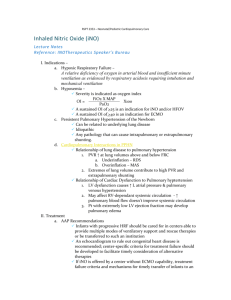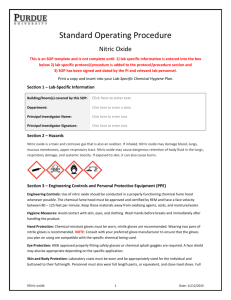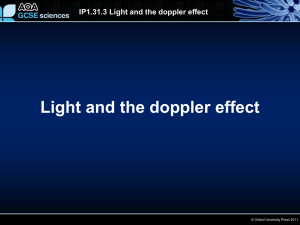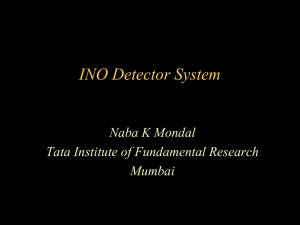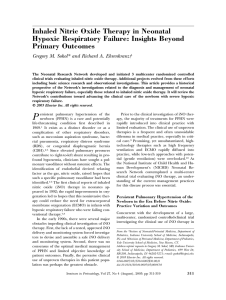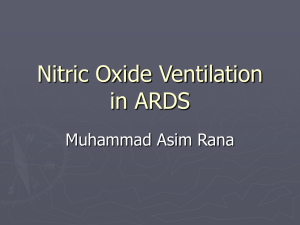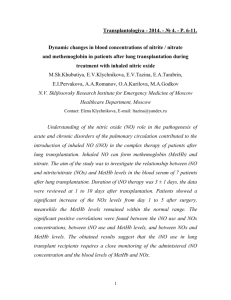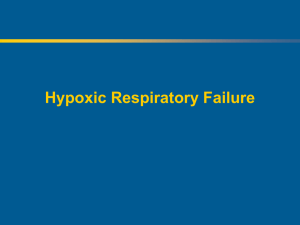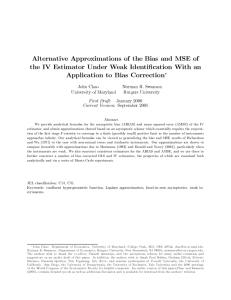A propensity-matched analysis of inhaled nitric oxide for Congenital
advertisement
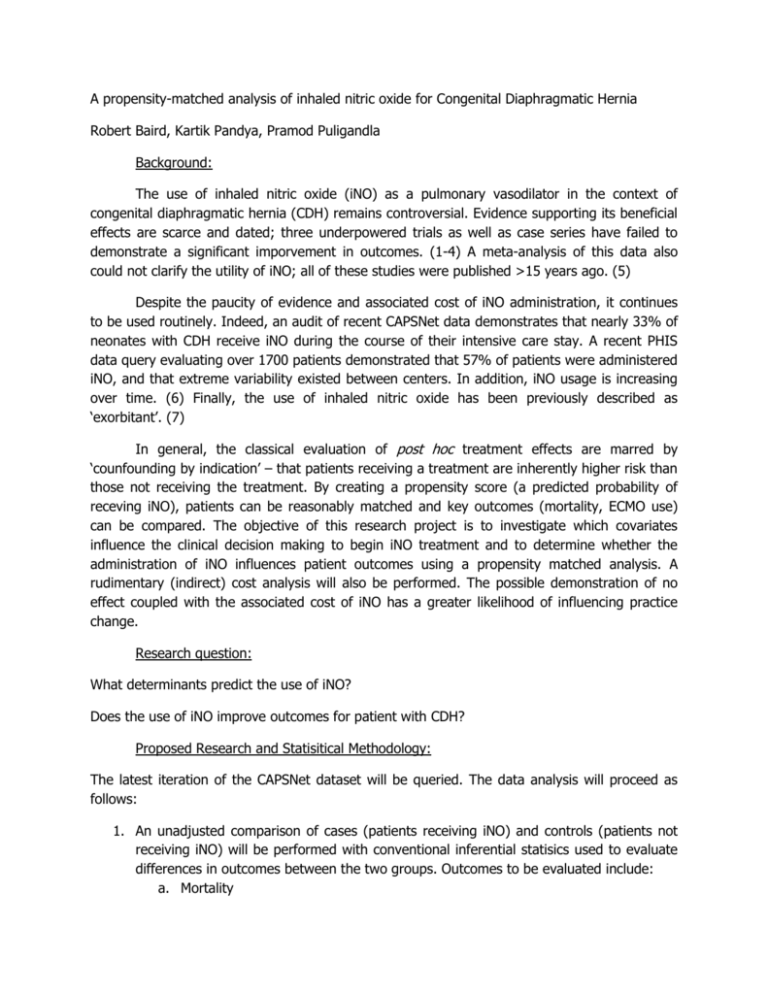
A propensity-matched analysis of inhaled nitric oxide for Congenital Diaphragmatic Hernia Robert Baird, Kartik Pandya, Pramod Puligandla Background: The use of inhaled nitric oxide (iNO) as a pulmonary vasodilator in the context of congenital diaphragmatic hernia (CDH) remains controversial. Evidence supporting its beneficial effects are scarce and dated; three underpowered trials as well as case series have failed to demonstrate a significant imporvement in outcomes. (1-4) A meta-analysis of this data also could not clarify the utility of iNO; all of these studies were published >15 years ago. (5) Despite the paucity of evidence and associated cost of iNO administration, it continues to be used routinely. Indeed, an audit of recent CAPSNet data demonstrates that nearly 33% of neonates with CDH receive iNO during the course of their intensive care stay. A recent PHIS data query evaluating over 1700 patients demonstrated that 57% of patients were administered iNO, and that extreme variability existed between centers. In addition, iNO usage is increasing over time. (6) Finally, the use of inhaled nitric oxide has been previously described as ‘exorbitant’. (7) In general, the classical evaluation of post hoc treatment effects are marred by ‘counfounding by indication’ – that patients receiving a treatment are inherently higher risk than those not receiving the treatment. By creating a propensity score (a predicted probability of receving iNO), patients can be reasonably matched and key outcomes (mortality, ECMO use) can be compared. The objective of this research project is to investigate which covariates influence the clinical decision making to begin iNO treatment and to determine whether the administration of iNO influences patient outcomes using a propensity matched analysis. A rudimentary (indirect) cost analysis will also be performed. The possible demonstration of no effect coupled with the associated cost of iNO has a greater likelihood of influencing practice change. Research question: What determinants predict the use of iNO? Does the use of iNO improve outcomes for patient with CDH? Proposed Research and Statisitical Methodology: The latest iteration of the CAPSNet dataset will be queried. The data analysis will proceed as follows: 1. An unadjusted comparison of cases (patients receiving iNO) and controls (patients not receiving iNO) will be performed with conventional inferential statisics used to evaluate differences in outcomes between the two groups. Outcomes to be evaluated include: a. Mortality i. Without surviving to surgery ii. Surviving to surgery b. ECMO use c. An aggregate of a. and b. d. Oxygen use at discharge 2. A multivariate logistic regression model will then be used to create a propensity score which reflects the predicted probability of each neonate receiving iNO. Covariates to be evaluated are stratified as follows: a. Prenatal (e.g. prenatal diagnosis Lung-head ratio, Liver position) b. At birth (e.g. Apgar, Gestational Age, Birthweight, Gender, defect sidedness, inborn, concomittant diagnosis) c. Postnatal (e.g. Prognostic scores [SNAP, CDHSG score, Santa Rosa score], Ventilatory mode [CMV, HFOV], Ventilatory pressures [PIP, PEEP, MAP], Ventilatory efficacy [PO2, PCO2, OI], Other [vasopressor and inotrope use, corticosteroids, surfactant, urine output, pH <7.25…] d. Systemic (e.g. hospital Volume, ECMO capabilities, year of treatment) 3. An adjusted comparison of the aformentioned outcomes after matching cases and controls 1:1 based on the propensity score of receving iNO. If 1:1 matching is not possible due to unequal numbers, an alternative matching plan may be considered in conjunction with a biostatician 4. A cost/day of iNO will be generated based on current costing. The additional overall cost/patient of iNO will then be calculated Time frame: All available years of CAPSNet data will be queried Inclusion/Exclusion: Inclusion: 1. Entered into the CDH database as having had CDH 2. Treated at a CAPSNet center 3. Closed file (in-hospital outcome complete) Exclusion: 1. In utero fetal demise (never treated post-natal) Expected Outcome and Mock Tables: 1. Unadjusted analysis Outcome Case (iNO), n= Mortality ECMO use Mortality and ECMO (combined outcome) Post-op vent days Length of Stay Ventilation mode at 72 hours Oxygen use at discharge Control (no iNO), n= P= P= P= P= P= 2. Covariate analysis Covariate Prenatal LHR o/e LHR TFLV o/e TFLV Liver position Associated anolamies At birth APGAR (5 min) Birthweight Gender Gestational age Outborn Postnatal SNAP score Ventilatory mode Pre-op ECHO (and degree of PHN) Pulmonary Vasodilators Inotropes 4 hour SAT 4 hour post-ductal PaO2 24 hour SAT 24 hour post-ductal PaO2 Pre-op SAT Pre-op post-ductal PaO2 Pre-op ECHO Size of defect (As per CAPSNet def) Patch (yes/no) Institutional Case (iNO), n= Control (no iNO), n= P= P= P= P= Year of treatment (before and after 2010) ECMO center (Y/N) Hospital Volume (Low, Medium, High), use CAPSNet defintion Hospital Geography (West, Central, East) Time of ICU admission (night vs not), use publiication definition 1. Adjusted analysis Outcome Case (iNO), n= Control (no iNO), n= Odds Ratio 95% CI Mortality ECMO use Mort and ECMO (combined) Post-op Vent days Length of stay Ventilation mode at 72 hours Oxygen use at discharge Problem of missing data: For variables with missing data, the mean of the variable will be inserted for continuous variables. Dichotomous variables will be dropped (and the ‘n’ adjusted accordingly). A sensitivity analysis will also be performed using a ‘complete case analysis’ in order to ascertain whether a significant difference exists in the result of complete versus ‘incomplete’ cases. Possible impact of results: Propensity matching affords the unique opportunity of identifying the determinants that predict iNO use for neonates with CDH. Once controlled for, a meaningful adjusted comparison of treated versus untreated patients is then possible. The results of this analysis should heavily influence the future use/disuse of iNO for patients with CDH both within and outside Canada. Given the popularity of the treatment, associated costs and the current lack of evidence supporting its use, the potential impact of this analysis is large; publication in a journal with wide readership is expected Specific Variables requested: Prenatal: Associated anomalies Cardiac anomalies Side of defect Herniated Liver Stomach position LHR o/e LHR TFLV (fetal MRI) o/e TFLV (fetal MRI) Demographic: Live birth (all variables, including delivery room intubation and labs) Gender Gestational age Weight Birth hospital: APGAR: Postnatal: Outborn Prenatal Diagnosis Transfusion Intubation Chest tube Inotropes Pulmonary vasodilators **Nitric Oxide (NO) – this variable is not expressly listed but is required All Ventilation modes Vent mode prior to surgery Surgery start/end time Location Surgeon Hernia Sac present Ipsilateral liver lobe Surgical Approach Materials for patch Abdo fascia closure Size of defect ECMO required Pre-op Echo (and degree of pulmonary hypertension) Post-op Echo (and degree of pulmonary hypertension) 4 hour, 24 hour , pre-op pH pre-ductal pO2 post-ductal pO2 Lactate HcO3 pre-ductal saturation post-ductal sturation FiO2 MAP BP Institutional Year of treatment ECMO center Hospital Volume Hospital Geography Time of ICU Admission Outcomes: ECMO use Post op vent days Mortality Length of Stay 72 hour vent mode Oxygen use at discharge Timeline: This study is expected to yield results with a high probability of shaping future practice patterns. It will be submitted to the AAP meeting (deadline spring 2015). References: 1. Inhaled nitric oxide and hypoxic repsiratoy failure in infants with congenital diaphragmastic hernia. The Neonatal Inhaled Nitric Oxide Group (NINOS). Pediatrics. 1997;99(6):838-45. 2. Karamanoukian HL, Glick PL, Zayek M, et al. Inhaled nitric oxide in the congenital hypoplasia of the lungs due to diaphragmtic hernmia or oligohydramnios. Pediatric 1994;94(5):715-8 3. Kinsella JP, Truog WE, Walsh WF, et al. (1997) Randomized, multicenter trial of inhaled nitric oxide and high-frequency oscillatory ventilation in severe, persistent pulmonary hypertension of the newborn. The Journal of pediatrics, 131(1), 55-62. 4. N Shah, T Jacob, R Exler, et al. Inhaled nitric oxide in congenital diaphragmatic hernia. J. Pediatr Surg 1994;29:8):1010-4. 5. Finer NN, Barrington KJ Nitric oxide in repiratory failure in the newborn infant. Semin Perinatol., 1997 21(5) 426-40. 6. Campbell BT, Herbs KW, Briden KE, et al. Inhaled nitric oxide use in neonates with congenital diaphragmatic hernia. Pediatrics 2014;134(2):e420-6. 7. C M Pierce, M J Peters, G Cohen et al. Cost of nitric oxide is exorbitant BMJ. Aug 10, 2002; 325(7359): 336.
